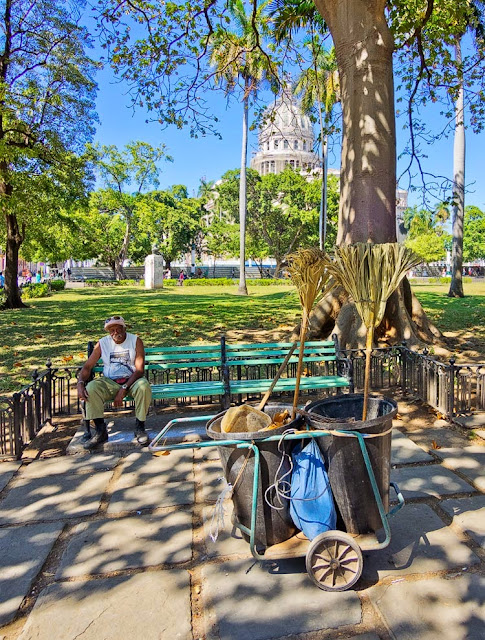 |
| Photo: Andrew Holman |
El Capitolio in Havana. Built in the 1920s, apparently with wealth generated from the post world war one sugar boom, its architectural style is described as 'eclectic': a mix of neoclassical and art nouveau, I've read. I love architectural eclecticism, which I take to mean: 'defies categorisation, does what it likes, is a bit of a rebel'. If I were a building, I'd like to be 'eclectic' too. Oh, and perhaps also to be constructed from snowy Capellania limestone like El Capitolio.
Eclectic is a word that aptly describes the mixture of life and activity that buzzes around the building too. The suave, but often beaten-up 1950s taxis come and go all day long, plying their trade along set routes across the city. These are what I call the 'shared' taxis'. (You can see the yellow taxi sign on the dashboard). They are economical and great fun to ride, my favourite way to get around bar two feet. You feel more Cuban, less tourist when you're riding them.
 |
| Photo: Andrew Holman |
El Capitolio is flanked by parks which are kept clean and pleasant by park cleaners using eco-friendly brooms of palm leaves. The brooms seem to do the job a treat and rustle soothingly for good measure.
Parks, of which there are many, are places to sit and watch the world go by, chat or eat the very sugary treats on sale from street vendors for a few pesos and adored by Cubans. The parks near El Capitolio are by no means quiet though; the engines in the old cars and lorries are not ashamed to make themselves heard nor do they mind coughing out diesel fumes.
 |
| Photo: Andrew Holman |
The building itself is immediately reminiscent of the Capitol Building in Washington DC and, in fact, is a half size replica of it. It was the tallest building in Cuba until the Bacardi building (see Cuba 8: Edificio Bacardi) was built in the 1930s. Like many important landmarks in Havana, it is currently closed for a facelift. When it re-opens, it is destined to take up its old place as the seat of Cuban government after a long spell in exile as the home of Cuba's Academy of Sciences. Perhaps its repatriation to the heart of the Cuban political system is in tune with the message of change that is on every street corner.
At present the whole area around El Capitolio is concealed from view by tall metal hoarding but this sneaky camera peek over the top gives a view of the gardens. These were designed by a French landscape designer and architect Jean Claude Nicolas Forestier. They are of formal layout, featuring Royal Palms (Roystonea). The patterns on the grass in the foreground suggest that many of the formal paths have grown over.
 |
| Photo: Andrew Holman |
What makes me smile most of all is the outdoor railway 'museum' next door. How wonderful if it were outside the Houses of Parliament in London, the 'set' for interviews with politicians. The possibilities for memorable sound bites would be endless. Those relating to measures to stoke up an ailing economy would be delivered by chancellors of the exchequer from the engine room.
No comments:
Post a Comment